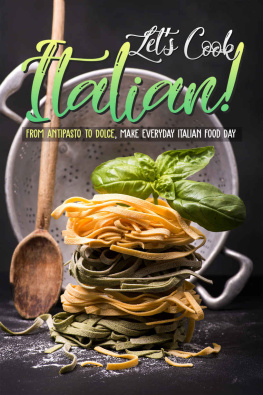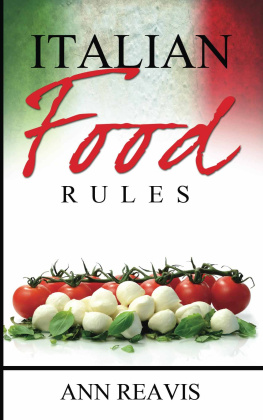INTRODUCTION
The Food of Italy:
Beyond Myths and Stereotypes

It is not down in any map; true places never are.
Herman Melville, Moby Dick
T iramisu. Spaghetti. Pizza. These items have become so pervasive that they come across as tired stereotypes. Even if many global consumers are not fully aware of their origin, Italian food is undoubtedly among the most palate-pleasing culinary traditions of the world. Its influence and appeal are increasing not only in the kitchen, but also in popular culture. A contemporary book about the recent developments in U.S. cuisine carries the title The United States of Arugula: How We Became a Gourmet Nation, focusing on the fashionable (and now ubiquitous) Italian green as a symbol of cosmopolitanism and culinary innovation. In the past three decades Italian cuisine has gained status as well as notoriety. It is not only served at family-style eateries, ice cream parlours and pizza shops: high-end Italian restaurants are now listed among the most prestigious establishments in major cities worldwide, receiving heartfelt accolades from both critics and patrons. TV shows and magazines are full of Italian recipes, all claiming authenticity, and culinary professionals become celebrities banking on their Italian origins. As Italian cuisine acquires new relevance, scores of travellers flock to the epicentre of it all: Italy. They come to unearth yet undiscovered traditions, to visit villages and farms off the beaten track and to savour unique products. They lounge in countryside villas while taking a break in between cooking classes with world-renowned chefs, or scout out mom-and-pop establishments to enjoy authentic local cuisine. So what is all the fuss about? How did Italian food manage to become what it is today? Why does it speak to so many people all over the world? Where does the apparently endless variety of local and regional cuisines come from? How did the dazzling and, frankly, quite confusing for many assortment of wines, cheeses, breads, vegetables and salamis come to be?

Unusual pasta types such as trofie from Liguria are attracting the attention of food enthusiasts all over the world.
B UILDING THE M YSTIQUE
When people find out I am from Italy, a question they frequently ask is: So, whats your favourite Italian restaurant?, which is usually followed by Do you cook every day? The assumption that I have a deep and innate connection with good food points to the widespread notion that Italy is, indeed, a special place when it comes to eating and the pleasures of the table. The world seems to be so in love with Italian food that many tend to think of it as exquisitely traditional, almost timeless, untouched by the events that have shaped what many consider a broken food system. Foodies are enraptured by its endless diversity and its capacity to intrigue and to always offer something new and hot. Tourists and travellers, often pleasantly surprised by their meals and the warm manners that surround them, end up projecting healthy amounts of romanticism on
The rhythm of Tuscan dining may throw us off but after a long lunch outside, one concept is clear siesta. The logic of a three-hour fall through the crack of the day makes perfect sense... My idea of heaven is a two-hour lunch with Ed, I believe he must have been Italian in another life. He has begun to gesture and wave his hands, which Ive never seen him do. He likes to cook at home but simply throws himself into it here.
Exposed to the influence of the environment and enthralled by the inevitable languor that apparently possesses everything and everybody in Italy, the foreign protagonists of Mayess story slowly change their behaviour. Time seems to lose its weight and its rigidity, melting into the pleasure of extended lunches and long naps, which are considered as essential to the natives lives as their gestures and flair for pleasure especially of the culinary kind.

The Tuscan landscape plays an important role in the mystique of the Italian countryside and its food.
The scandalous fame of extra-virgin olive oil
Extra-virgin olive oil is certainly among the most sought-after of Italian products and a symbol of the Mediterranean diet. Each variety of olive, or cultivar, differs in size, taste and growing periods, creating a multiplicity of local varieties. Following the increasing appreciation for the cultural and economic value of the product, in recent years the profession of olive-oil taster has been publicly recognized, and also the more refined consumers are now aware of the impact of elements such as growing areas, cultivar and harvesting times. Small productions, difficult to purchase and frankly quite expensive, enjoy unprecedented success. Nevertheless, for everyday use, most consumers still buy mass-produced olive oils, sensitive to prices more than just quality.
Often referred to as liquid gold, both for its unique hue and its commercial value, extra-virgin olive oil has been the focus of rural and trade policies aimed at guaranteeing its origin and its quality. In fact, the sector is plagued by a long history of adulteration and counterfeiting. Olive oil is classified in different grades according to extraction methods, taste and oleic acid content, with extra-virgin olive oil having an acidity lower than 0.8 per cent, with an absolutely perfect taste. However, many producers argue that these measurements are not enough to limit the sales of cheap deodorized oils, which are chemically purified to get rid of smells connected with defective production.















